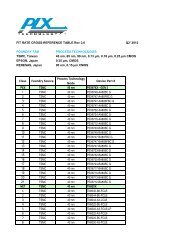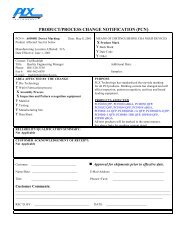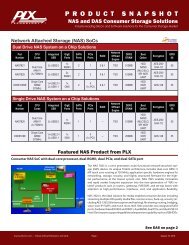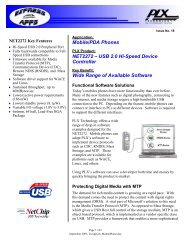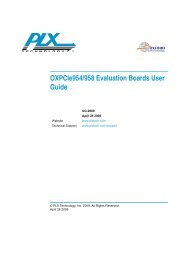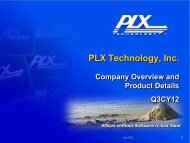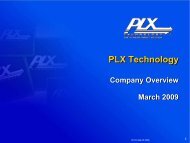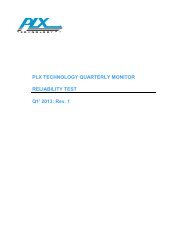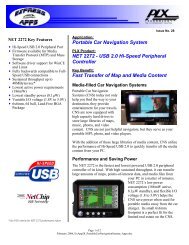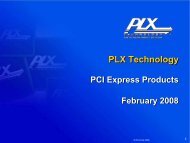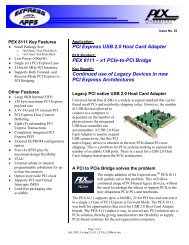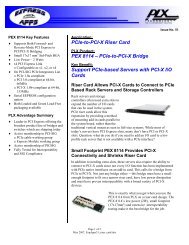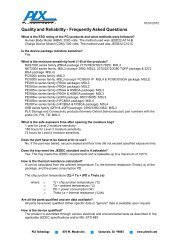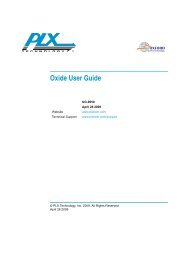the 2009 Annual Report (pdf) - PLX Technology
the 2009 Annual Report (pdf) - PLX Technology
the 2009 Annual Report (pdf) - PLX Technology
You also want an ePaper? Increase the reach of your titles
YUMPU automatically turns print PDFs into web optimized ePapers that Google loves.
and recorded at <strong>the</strong> rate in effect at <strong>the</strong> date of <strong>the</strong> transactions. The effects of <strong>the</strong> remeasurement are included within<br />
o<strong>the</strong>r income, net in <strong>the</strong> Consolidated Statements of Operations.<br />
Income Taxes<br />
Income taxes are accounted for using <strong>the</strong> asset and liability method. Under this method, deferred tax liabilities<br />
and assets are recognized for <strong>the</strong> expected future tax consequences of differences between <strong>the</strong> carrying amounts and<br />
<strong>the</strong> tax bases of assets and liabilities. A valuation allowance is provided when it is more likely than not that all or<br />
some portion of deferred tax assets will not be realized.<br />
Revenue Recognition<br />
The Company recognizes revenue when persuasive evidence of an arrangement exists, delivery has occurred, <strong>the</strong><br />
fee is fixed or determinable, and collection is reasonably assured.<br />
Revenue from product sales to direct customers and distributors is recognized upon shipment and transfer of risk<br />
of loss, if <strong>the</strong> Company believes collection is reasonably assured and all o<strong>the</strong>r revenue recognition criteria are met.<br />
The Company assesses <strong>the</strong> probability of collection based on a number of factors, including past transaction history<br />
and <strong>the</strong> customer’s creditworthiness. At <strong>the</strong> end of each reporting period, <strong>the</strong> sufficiency of allowances is assessed<br />
based on <strong>the</strong> age of <strong>the</strong> receivable and <strong>the</strong> individual customer’s creditworthiness.<br />
The Company offers pricing protection to two distributors whereby <strong>the</strong> Company supports <strong>the</strong> distributor’s resale<br />
product margin on certain products held in <strong>the</strong> distributor’s inventory. The Company analyzes current requests for<br />
credit in process, also known as ship and debits, and inventory at <strong>the</strong> distributor to determine <strong>the</strong> ending sales reserve<br />
required for this program. The Company also offers stock rotation rights to three distributors such that <strong>the</strong>y can return<br />
up to a total of 5% of products purchased every six months in exchange for o<strong>the</strong>r <strong>PLX</strong> products of equal value. The<br />
Company analyzes current stock rotation requests and past experience to determine <strong>the</strong> ending sales reserve required<br />
for this program. In addition, <strong>the</strong> Company has arrangements with a small number of customers offering a rebate<br />
program on various products. The Company records rebates as a reduction of revenue when <strong>the</strong> rebate is in <strong>the</strong> form<br />
of cash consideration or a reduction to accounts receivable. Reserves are reduced directly from revenue and recorded<br />
as a reduction to accounts receivable.<br />
Product Warranty<br />
The Company sells products with a limited warranty of product quality for a period of one year, and up to three<br />
years for a small number of customers, and a limited indemnification of customers against intellectual property<br />
infringement claims related to <strong>the</strong> Company’s products. The Company accrues for known warranty and<br />
indemnification issues if a loss is probable and can be reasonably estimated, and accrues for estimated incurred but<br />
unidentified issues based on historical activity.<br />
Use of Estimates<br />
The preparation of financial statements in conformity with accounting principles generally accepted in <strong>the</strong> United<br />
States requires management to make estimates and assumptions that affect various accounts, including but not limited<br />
to goodwill, long-lived assets, income taxes, inventories, revenue recognition, allowance for doubtful accounts, sharebased<br />
compensation and warranty reserves as reported in <strong>the</strong> financial statements and accompanying notes. Actual<br />
results could differ from those estimates and such differences may be material to <strong>the</strong> consolidated financial<br />
statements.<br />
47




